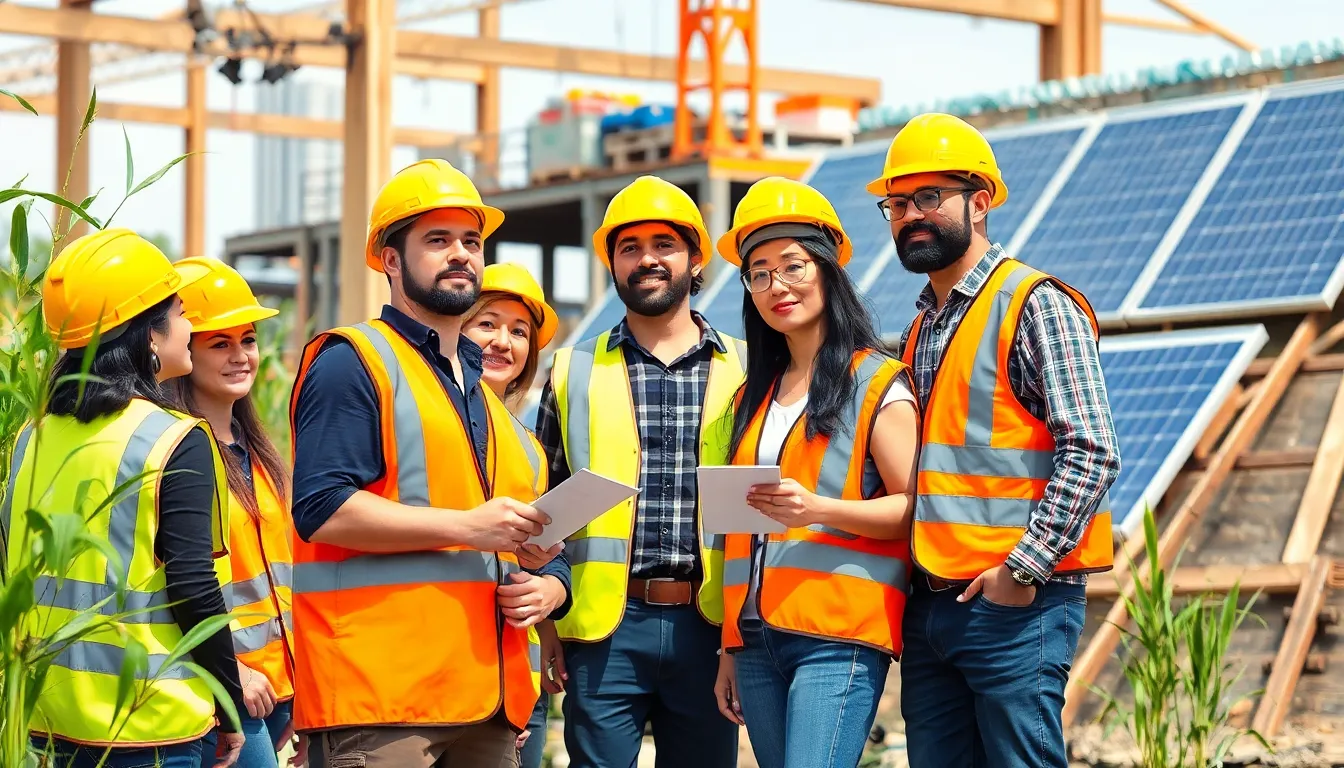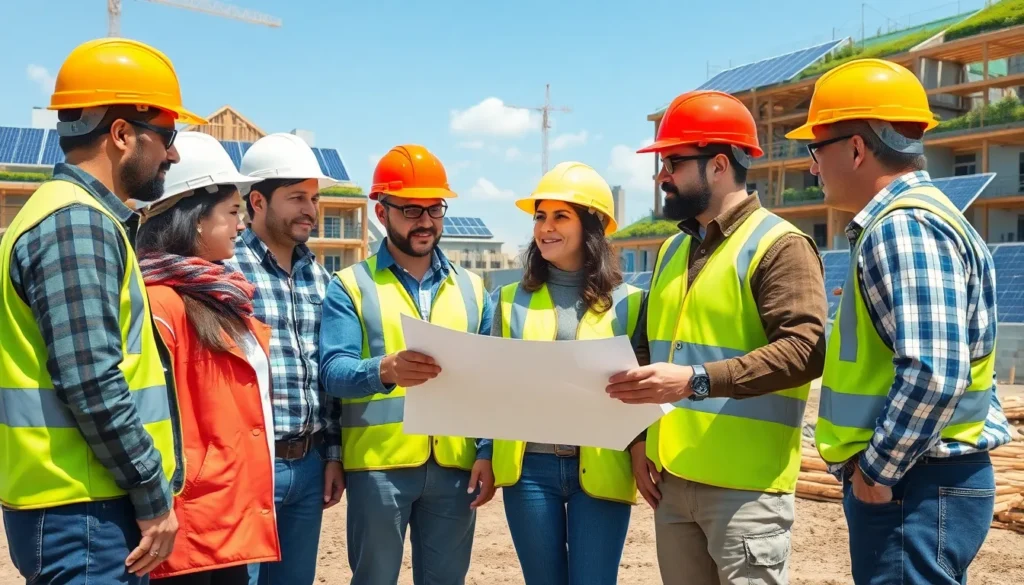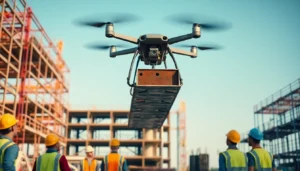Table of Contents
ToggleIn a world where construction often feels like a race to the bottom—think concrete jungles and endless waste—sustainable construction technology emerges as the superhero we didn’t know we needed. It’s like the eco-friendly cape that architects and builders can wear while saving the planet, one green brick at a time. Imagine structures that don’t just stand tall but also breathe, thrive, and coexist with nature.
Overview Of Sustainable Construction Technology
Sustainable construction technology encompasses innovative practices aimed at minimizing environmental impact. This approach utilizes materials and methods that reduce resource consumption while promoting energy efficiency. Renewable resources, such as bamboo and recycled steel, often replace traditional building materials, thereby minimizing waste and preserving natural ecosystems.
Energy-efficient systems, including solar panels and green roofs, enhance building functionality. These designs reduce reliance on fossil fuels, contributing to lower greenhouse gas emissions. Water conservation technologies, like rainwater harvesting systems, help maintain local water supplies while promoting sustainable landscapes.
Sustainable construction prioritizes lifecycle assessments to measure the environmental effects of building materials and processes. These assessments evaluate lasting impacts on air quality, water resources, and overall ecosystem health. Building Information Modeling (BIM) enhances these evaluations by providing detailed insights into project efficiency and waste management during construction.
Developers and clients increasingly value sustainable designs for their long-term economic benefits. Green buildings often lead to lower operational costs, improved marketability, and higher operating efficiency. Certifications, such as LEED and BREEAM, play a crucial role in recognizing sustainable practices and enticing investment in eco-friendly projects.
A growing number of construction firms adopt these cutting-edge technologies, showcasing a shift toward environmental responsibility in the industry. This transformation not only benefits individual projects but also supports global efforts to mitigate climate change. Reducing carbon footprints through sustainable practices marks a significant step forward for the construction sector.
Benefits Of Sustainable Construction Technology

Sustainable construction technology offers numerous benefits, particularly in terms of environmental protection and economic gain. These advantages are reshaping the future of the construction industry.
Environmental Impact
Sustainable construction significantly reduces environmental degradation. Green building materials, such as recycled steel and bamboo, lower the demand for new resources. Energy-efficient systems, including solar panels, decrease reliance on fossil fuels. Rainwater harvesting systems conserve local water supplies while promoting sustainable landscaping. These technologies minimize greenhouse gas emissions and enhance air quality. Lifecycle assessments evaluate the impact of materials and processes, enabling informed decisions that support ecosystem health. Stakeholders increasingly value projects that prioritize sustainability, recognizing their role in mitigating climate change.
Economic Advantages
Economic benefits arise from investing in sustainable construction technologies. Green buildings often lead to lower operational costs due to energy efficiency. Studies show that sustainable designs can improve a property’s marketability, attracting more buyers. Certifications like LEED and BREEAM enhance credibility, providing a competitive edge. Developers often find that eco-friendly projects yield higher returns on investment. As awareness of environmental issues grows, more clients prioritize sustainability, resulting in long-term financial advantages for construction firms. Adopting these technologies fosters innovation while driving demand for responsible building practices.
Types Of Sustainable Construction Technologies
Sustainable construction technologies incorporate various innovative methods and materials that aim to minimize environmental impacts. Key categories include renewable energy solutions, green building materials, and waste reduction techniques.
Renewable Energy Solutions
Solar panels represent a primary renewable energy solution. These systems convert sunlight into electricity, significantly reducing dependence on fossil fuels. Wind turbines also generate clean energy, harnessing wind currents to power buildings. Geothermal heating and cooling systems utilize the Earth’s stable underground temperature, enhancing energy efficiency. Incorporating these technologies not only lowers greenhouse gas emissions but also promotes energy independence.
Green Building Materials
Many construction projects now utilize green building materials to reduce ecological footprints. Bamboo stands out due to its rapid growth and renewability, providing a strong, sustainable alternative to traditional woods. Recycled steel minimizes resource extraction and reduces waste in landfills. Other options include reclaimed wood, which repurposes existing materials, and low-VOC (volatile organic compound) paints that ensure better indoor air quality. These choices contribute to eco-friendly construction and support healthier living environments.
Waste Reduction Techniques
Effective waste reduction techniques play a crucial role in sustainable construction. Construction and demolition waste recycling enables builders to reuse materials, minimizing landfill contributions. Prefabrication reduces on-site waste through off-site component creation, optimizing resource use before the building stage. Additionally, implementing efficient management strategies, such as just-in-time delivery, ensures that materials arrive only as needed. Together, these practices significantly cut material waste and promote a circular economy in construction.
Implementing Sustainable Construction Practices
Sustainable construction practices focus on minimizing environmental impact while maximizing efficiency. They require thoughtful planning and design as well as compliance with a growing body of regulations.
Planning And Design Considerations
Effective planning and design serve as the foundation for sustainable construction. Architects and builders must prioritize sustainable materials like bamboo and recycled steel, which reduce ecological footprints. Energy-efficient systems including solar panels and green roofs require careful integration to optimize building performance. Utilizing Building Information Modeling, or BIM, allows teams to assess project efficiency and resource management more accurately. Engaging stakeholders early fosters collaboration, ensuring that all ideas align with sustainability goals. Cost-benefit analysis helps in understanding the long-term savings associated with eco-friendly designs. Streamlining workflows also leads to diminished waste during construction phases.
Regulatory Compliance
Compliance with local and international regulations plays a crucial role in promoting sustainable construction. Governments often implement measures to encourage green practices, including incentives for energy efficiency and waste reduction. Familiarity with regulations like LEED and BREEAM aids developers in achieving recognized certifications that enhance marketability. Ensuring adherence to zoning laws and building codes fosters a seamless construction process. Knowledge of environmental impact assessments allows teams to evaluate potential project consequences on air quality and water resources. Staying updated on evolving regulations supports continual improvement and innovation in sustainable practices. Collaboration with regulatory agencies further streamlines these compliance efforts, enabling a smoother path to achieving sustainability objectives.
Future Trends In Sustainable Construction Technology
Emerging technologies in sustainable construction focus on enhancing efficiency and reducing impact. Artificial intelligence optimizes designs for energy savings and resource management. Construction firms increasingly adopt modular construction methods, which cut waste and speed up project timelines.
3D printing is transforming the industry by enabling the creation of customized building components with minimal resource use. Virtual reality tools aid in visualizing designs while helping clients understand sustainability features. Developers embrace smart materials that adapt to environmental changes, such as structures that respond to temperature or humidity levels.
Additionally, the integration of Internet of Things (IoT) technology allows for real-time monitoring of energy usage and resource consumption. Efficient data analytics enhance project management and facilitate continuous improvement in building performance. Governments worldwide emphasize sustainable policies, giving rise to incentives for green building practices and investments.
Recent studies reveal a significant shift in market demand toward sustainable buildings. Consumers increasingly prefer eco-friendly options, making sustainability a key selling point. Collaborative efforts among architects, engineers, and construction managers foster innovative solutions that promote sustainability.
Investment in renewable energy sources further signifies a commitment to lowering carbon footprints. Consequently, energy-efficient features, such as smart grid technology, become essential in new projects. Adoption of these trends not only benefits the environment but also supports the long-term financial success of construction firms. Energy performance certifications gain importance as clients seek assurances of sustainability in their projects.
Innovation, efficiency, and eco-friendliness will shape the future of construction, driving progress toward a more sustainable industry.
Sustainable construction technology represents a pivotal shift in the building industry. By integrating eco-friendly practices and innovative materials, it not only addresses environmental concerns but also enhances economic viability. As stakeholders increasingly recognize the long-term benefits of green buildings, the demand for sustainable solutions will continue to rise.
The future of construction lies in the hands of those who embrace these technologies. With a focus on efficiency and resource management, the industry can significantly reduce its carbon footprint. Collaboration among architects, engineers, and developers will drive the adoption of these practices, ensuring that sustainability becomes the norm rather than the exception. The path forward is clear: innovation and environmental responsibility will shape a brighter future for construction.







